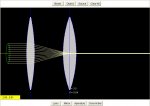
Welcome to Laser Pointer Forums - discuss green laser pointers, blue laser pointers, and all types of lasers
How to Register on LPF | LPF Donations
Navigation
Install the app
How to install the app on iOS
Follow along with the video below to see how to install our site as a web app on your home screen.
Note: This feature may not be available in some browsers.
More options

You are using an out of date browser. It may not display this or other websites correctly.
You should upgrade or use an alternative browser.
You should upgrade or use an alternative browser.
divergence question
- Thread starter payj
- Start date


- Joined
- Feb 20, 2008
- Messages
- 24
- Points
- 0
whats divergence 
Hi
http://en.wikipedia.org/wiki/Beam_divergence
Generally the answer to your question is yes.
Although, focus has an ability to change a "local" point diameter, generally speaking pre made lasers arrive focused to a minimal divergance.
It is possible to change the focus and alter the dot diameter. The original divergence is still available but thru focal tuning the point is no longer within the factory setting.
http://en.wikipedia.org/wiki/Beam_divergence
I am sorry I forgot who posted this link, but I book marked it:
http://www.hazelwood.k12.mo.us/~grichert/optics/intro.html
Have a go at optic testing and you should get an idea how focus and distance relate via the "beam" and a couple "lens" additions.
If your able to shrink the beam on your optic tool, you should realize that focusing a single lens will alter the "converge spread" of a single lens, whereas as dual lens array can actually minimize the beam diameter over prolonged distances.
SN
http://en.wikipedia.org/wiki/Beam_divergence
Generally the answer to your question is yes.
Although, focus has an ability to change a "local" point diameter, generally speaking pre made lasers arrive focused to a minimal divergance.
It is possible to change the focus and alter the dot diameter. The original divergence is still available but thru focal tuning the point is no longer within the factory setting.
http://en.wikipedia.org/wiki/Beam_divergence
I am sorry I forgot who posted this link, but I book marked it:
http://www.hazelwood.k12.mo.us/~grichert/optics/intro.html
Have a go at optic testing and you should get an idea how focus and distance relate via the "beam" and a couple "lens" additions.
If your able to shrink the beam on your optic tool, you should realize that focusing a single lens will alter the "converge spread" of a single lens, whereas as dual lens array can actually minimize the beam diameter over prolonged distances.
SN
so basically divergance in the case of lasers means how fast a beam gets bigger, starting from the aperture and continuing on until the dot is disrupted.
In lasers, a smaller divergance usually is better, because the beam stays small and tight for a longer distance.
Divergance can be changed easily with lenses, although it takes skill and money to make the divergance of your laser smaller.
In lasers, a smaller divergance usually is better, because the beam stays small and tight for a longer distance.
Divergance can be changed easily with lenses, although it takes skill and money to make the divergance of your laser smaller.
- Joined
- Oct 24, 2006
- Messages
- 2,032
- Points
- 38
FACT: Divergence and Beam diameter are inversely proportional like speed at torque. So if you double the minimum beam diameter, you can halve the divergence, or vice versa. You gotta take that compromise though.
????????? Where'd you hear that one :-/laserterd said:That is one of the ways to also get a beam below the diameter that the wavelength is. Traditionally a 532nm laser could not have a beam diameter less than 532nm, but if you expand i then refocus it to be super small again, it can be smaller
L
likewhat
Guest
laserterd said:That is one of the ways to also get a beam below the diameter that the wavelength is. Traditionally a 532nm laser could not have a beam diameter less than 532nm, but if you expand i then refocus it to be super small again, it can be smaller
You should probably write a paper on that and publish it in Nature, because right now you are the only one who knows how to do that.
- Joined
- Aug 15, 2007
- Messages
- 1,880
- Points
- 0
Cos they're always right 
The graphic from supernova is very illustrative, but a bit misleading. Geometric optics makes you think you can get a nice straight beam, however no matter how great your lens system, your beam will always diverge. If you want to know how fast, you can measure with your power measurement device of choice, a razor blade, a translating stand (preferably with an extremely fine scale), and a lot of patience.


